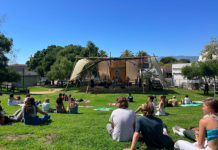Francisco Olvera
South Park continued its cultural and social commentary in this week’s episode titled “The City Part of Town.” They continued to run the storyline of the past two episodes of this season, which contained the introduction of the character, PC (Politically Correct) Principal; and Mr. Garrison’s campaign for president of the United States.
PC Principal represents the radically left side of liberals by being militant and melodramatic toward others when they lack social consciousness (for example, in the first episode of this season, Cartman said “spokesman” instead of “spokesperson” and PC Principal lost it and beat him to a pulp). Mr. Garrison, on the other hand, parallels the current leading Republican candidate, Donald Trump.
This latest episode began with Jimmy Fallon insulting Mr. Garrison, calling him “basically an idiot.” After that, Fallon goes on to insult South Park the town as a whole, calling them a “predominately white town” and making them out to be unintelligent rednecks.
After witnessing this, the town is unhappy, and thus begins to think about ways in which they can change their image. Randy Marsh comes up with the solution: he proposes to get a Whole Foods in South Park, claiming that it would “instantly validate [them] as a town that cares about stuff.” However, they can only do this if they become a modern town. Enter the main critique of this episode: gentrification.
For those not familiar with the term, gentrification is the practice of renovating and improving houses or districts so that they resemble and conform to a middle-class state. The problem with this, however, is that not everybody is middle-class, so not everybody benefits from the modernization.
The district they choose to renovate is where Kenny’s house is located, given that his family is the poorest of the town. They decide to keep Kenny’s house because they claim that the “hipsters” will like it. Again, through this, South Park critiques the middle-class state through people who are a part of it: the “hipsters” (it is no mistake that a waiter at one of the new restaurants has a handle bar mustache and a man bun).
Another issue that arises thanks to the “updated” area is that that old businesses are put out of business because everyone wants to go to the new area. The restaurant owner of City Wok, Tuong Lu Kim, experiences this firsthand when he no longer has any customers.
Later in the episode, Randy calls Whole Foods and gets someone to agree to come check out South Park, to see if it is ready for a Whole Foods.
Kenny and his family continue to see the adverse effects of gentrification as they are surrounded by places they cannot afford, like an ice cream shop that sells ten dollar ice cream. Kenny decides to go out looking for a job and finds one at City Wok, where children are being employed. An interesting thing to point out during this scene is that all of the children lined up to work are minorities, with the exception of Kenny. Still, Kenny’s presence is due to his low-income status, regardless of the fact that he is white. This episode, again, critiques the effects gentrification has on low-income families, especially minorities given that they are the ones more likely to be low-income.
The Whole Foods ends up being placed right next to City Wok, while Kenny’s area still contains all of the restaurants and shops, except that they are abandoned. The last scene is that of the South Park residents shopping at the new Whole Foods. Minorities are seen shopping there as well, but they look confused.
The irony found in this episode is that in creating a new image of the town, the town left out some of its residents. Thus, this episode wishes to point out that the social and cultural obsession with modernity doesn’t always create equality.
















